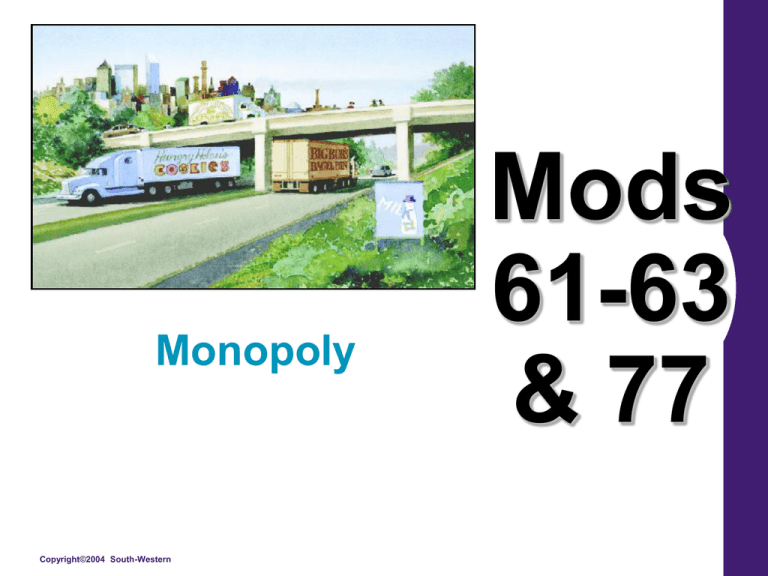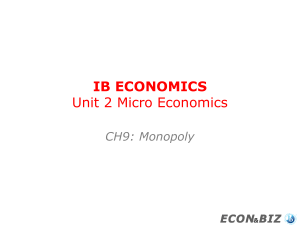monopoly - TeacherWeb
advertisement

Monopoly Copyright©2004 South-Western Mods 61-63 & 77 MONOPOLIES • While a competitive firm is a price taker, a monopoly firm is a price maker. Copyright © 2004 South-Western MONOPOLIES • A firm is considered a monopoly if . . . • it is the sole seller of its product. • its product does not have close substitutes. Copyright © 2004 South-Western WHY MONOPOLIES ARISE • The fundamental cause of monopoly is barriers to entry. Copyright © 2004 South-Western WHY MONOPOLIES ARISE • Barriers to entry have three sources: • Ownership of a key resource. • The government gives a single firm the exclusive right to produce some good. • Costs of production make a single producer more efficient than a large number of producers. Copyright © 2004 South-Western Monopoly Resources • Although exclusive ownership of a key resource is a potential source of monopoly, in practice monopolies rarely arise for this reason. • Examples: • ALCOA • DeBeers Copyright © 2004 South-Western Government-Created Monopolies • Governments may restrict entry by giving a single firm the exclusive right to sell a particular good in certain markets. • Patents, trademarks, and copyright laws are two important examples of how government creates a monopoly to serve the public interest. Copyright © 2004 South-Western Natural Monopolies • An industry is a natural monopoly when a single firm can supply a good or service to an entire market at a smaller cost than could two or more firms. Copyright © 2004 South-Western Natural Monopolies • A natural monopoly arises when there are economies of scale over the relevant range of output. Copyright © 2004 South-Western HOW MONOPOLIES MAKE PRODUCTION AND PRICING DECISIONS • Monopoly versus Perfect Competition • Monopoly • • • • Is the sole producer Faces a downward-sloping demand curve Is a price maker Reduces price to increase sales • Perfectly Competitive Firm • • • • Is one of many producers Faces a horizontal demand curve Is a price taker Sells as much or as little at same price Copyright © 2004 South-Western Demand Curves for Competitive and Monopoly Firms A Competitive Firm ‘s Demand Curve ’ Price A Monopolist ‘s ’Demand Curve Price Demand Demand 0 Quantity of Output 0 Quantity of Output Copyright © 2004 South-Western A Monopoly’s Revenue • Total Revenue P Q = TR • Average Revenue TR/Q = AR = P • Marginal Revenue DTR/DQ = MR Copyright © 2004 South-Western A Monopoly’s Total, Average, and Marginal Revenue Copyright©2004 South-Western A Monopoly’s Revenue • A Monopoly’s Marginal Revenue • A monopolist’s marginal revenue is always less than the price of its good. • The demand curve is downward sloping. • When a monopoly drops the price to sell one more unit, the revenue received from previously sold units also decreases. Copyright © 2004 South-Western A Monopoly’s Revenue • A Monopoly’s Marginal Revenue • When a monopoly increases the amount it sells, it has two effects on total revenue (P Q). • The quantity or output effect—more output is sold, so Q is higher. • The price effect—price falls, so P is lower. Copyright © 2004 South-Western Demand and Marginal Revenue Curves for a Monopoly Price $11 10 9 8 7 6 5 4 3 2 1 0 –1 –2 –3 –4 D-AR-P 1 2 3 4 5 6 7 8 Quantity of Water MR Copyright © 2004 South-Western Monopoly Profit Maximization • A monopoly maximizes profit by producing the quantity at which marginal revenue equals marginal cost. • It then uses the demand curve to find the price that will induce consumers to buy that quantity. Copyright © 2004 South-Western Profit Maximization for a Monopoly Costs and Revenue 2. . . . and then the demand curve shows the price consistent with this quantity. 1. The intersection of the marginal-revenue curve and the marginal-cost curve determines the profit-maximizing quantity . . . B Monopoly price Average total cost A D-AR-P Marginal cost MR 0 Q QMAX Q Quantity Copyright © 2004 South-Western PC vs M Profit Maximization • Comparing Monopoly and Perfect Competition • For a competitive firm, price equals marginal cost. P = MR = MC • For a monopoly firm, price exceeds marginal cost. P > MR = MC Copyright © 2004 South-Western A Monopoly’s Profit • Profit equals total revenue minus total costs. • Profit = TR – TC • Profit = (P - ATC) Q Copyright © 2004 South-Western The Monopolist’s Profit Costs and Revenue Marginal cost Monopoly E price B Monopoly profit Average total D cost Average total cost C D-AR-P Marginal revenue 0 QMAX Quantity Copyright © 2004 South-Western A Monopolist’s Profit • The monopolist will receive economic profits as long as price is greater than average total cost. Copyright © 2004 South-Western THE WELFARE COST OF MONOPOLY • In contrast to a competitive firm, the monopoly charges a price above the marginal cost. • From the standpoint of consumers, this high price makes monopoly undesirable. • However, from the standpoint of the owners of the firm, the high price makes monopoly very desirable. Copyright © 2004 South-Western The Deadweight Loss • Because a monopoly sets its price above marginal cost, it places a wedge between the consumer’s willingness to pay and the producer’s cost. • This wedge causes the quantity sold to fall short of the social optimum. • That “wedge” is called Deadweight Loss Copyright © 2004 South-Western The Inefficiency of Monopoly Price Deadweight loss Marginal cost Monopoly price Marginal revenue 0 Monopoly Efficient quantity quantity D-AR-P Quantity Copyright © 2004 South-Western The Deadweight Loss • The Inefficiency of Monopoly • The monopolist produces less than the socially efficient quantity of output. Copyright © 2004 South-Western PRICE DISCRIMINATION • Price discrimination is the business practice of selling the same good at different prices to different customers, even though the costs for producing for the two customers are the same. Copyright © 2004 South-Western PRICE DISCRIMINATION • Price discrimination is not possible when a good is sold in a competitive market since there are many firms all selling at the market price. In order to price discriminate, the firm must have some market power. • Perfect Price Discrimination • Perfect price discrimination refers to the situation when the monopolist knows exactly the willingness to pay of each customer and can charge each customer a different price. Copyright © 2004 South-Western PRICE DISCRIMINATION • Two important effects of price discrimination: • It can increase the monopolist’s profits. • It can reduce deadweight loss. Copyright © 2004 South-Western Welfare with and without Price Discrimination Monopolist with Single Price Price Consumer surplus Deadweight loss Monopoly price Profit Marginal cost Marginal revenue 0 Quantity sold Demand Quantity Copyright © 2004 South-Western Welfare with and without Price Discrimination Monopolist with Perfect Price Discrimination Price Profit Marginal cost Demand 0 Quantity sold Quantity Copyright © 2004 South-Western PRICE DISCRIMINATION • Examples of Price Discrimination • Movie tickets • Airline prices • Inside American Airlines film clip • Discount coupons • Financial aid • Quantity discounts Copyright © 2004 South-Western PUBLIC POLICY TOWARD MONOPOLIES • Government responds to the problem of monopoly in one of four ways. • Making monopolized industries more competitive. • Regulating the behavior of monopolies. • Turning some private monopolies into public enterprises. • Doing nothing at all. Copyright © 2004 South-Western Increasing Competition with Antitrust Laws • Antitrust laws are a collection of statutes aimed at curbing monopoly power. • Antitrust laws give government various ways to promote competition. • They allow government to prevent mergers. • They allow government to break up companies. • They prevent companies from performing activities that make markets less competitive. Copyright © 2004 South-Western Increasing Competition with Antitrust Laws • Two Important Antitrust Laws • Sherman Antitrust Act (1890) • Reduced the market power of the large and powerful “trusts” of that time period. • Clayton Act (1914) • Strengthened the government’s powers and authorized private lawsuits. • Rodino Act (1976) • Requires proposed mergers to be reviewed by either DOJ or FTC for approval Copyright © 2004 South-Western Regulation of Monopolies 1. Average Cost Pricing— sometimes called Fair Market Pricing • Set price not at Monopoly price level, but where ATC crosses D • You are acting like this is a PC firm and that MR is with DARP, and then setting price at the ATC curve • Monopolist will make 0 Econ Profits • Consumers gain in some more Q produced, so less DWL and lower price Copyright © 2004 South-Western Regulation of Monopolies 2. Marginal Cost Pricing— sometimes called Socially Efficient Pricing • • • • Set price not at Monopolist price level but where MC crosses D Now you are acting like it is a PC firm and that MR is with DARP, and then set price at totally efficient level of MC = MR Monopolist will lose $ --the price will be below ATC; Monopolist needs a subsidy to do this Consumers gain w/no DW Loss, lower price in market Copyright © 2004 South-Western Regulating a Natural Monopoly Unregulated Monopoly Average Cost Pricing Marginal Cost Pricing Copyright © 2004 South-Western Public Ownership of Monopolies • Rather than regulating a natural monopoly that is run by a private firm, the government can run the monopoly itself (e.g. Amtrak, Post Office, state ABC liquor stores). Copyright © 2004 South-Western Doing Nothing • Government can do nothing at all if the market failure is deemed small compared to the imperfections of public policies. Copyright © 2004 South-Western CONCLUSION: THE TRUTH ABOUT MONOPOLIES • Are Monopolists just being greedy? • Do Monopolists charge the highest possible price? • Are Monopolists guaranteed a profit? Copyright © 2004 South-Western CONCLUSION: THE PREVALENCE OF MONOPOLY • How prevalent are the problems of monopolies? • Firms with pure and substantial monopoly power are rare, b/c few goods are truly unique, or have no substitutes • Most firms have some control over their prices because of differentiated products. Copyright © 2004 South-Western






